2017 TOYOTA TACOMA clutch
[x] Cancel search: clutchPage 3 of 640
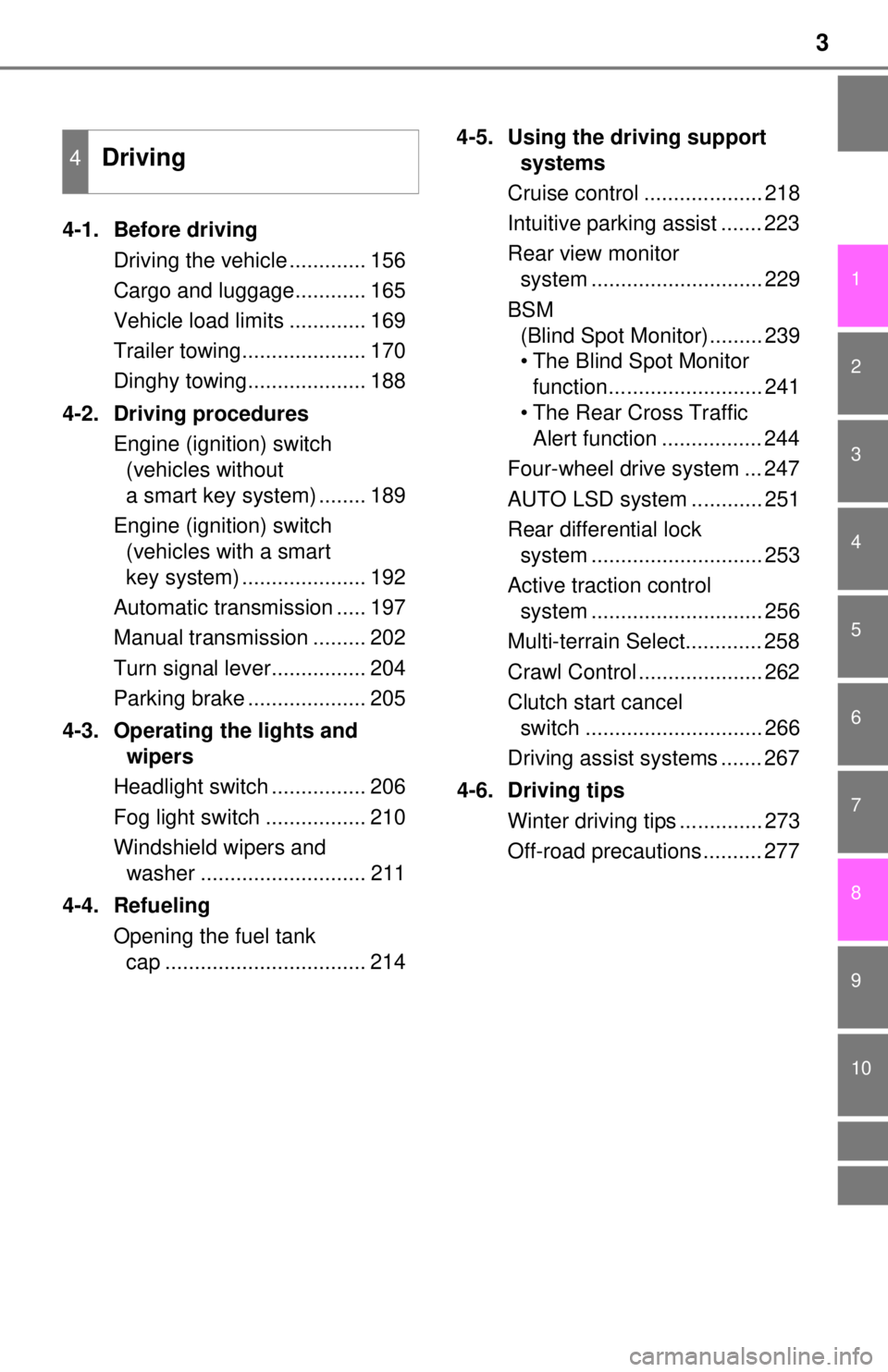
3
1
9 8
7 5 4
3
2
10
6
4-1. Before drivingDriving the vehicle ............. 156
Cargo and luggage............ 165
Vehicle load limits ............. 169
Trailer towing..................... 170
Dinghy towing.................... 188
4-2. Driving procedures Engine (ignition) switch (vehicles without
a smart key system) ........ 189
Engine (ignition) switch (vehicles with a smart
key system) ..................... 192
Automatic transmission ..... 197
Manual transmission ......... 202
Turn signal lever................ 204
Parking brake .................... 205
4-3. Operating the lights and wipers
Headlight switch ................ 206
Fog light switch ................. 210
Windshield wipers and washer ............................ 211
4-4. Refueling Opening the fuel tank cap .................................. 214 4-5. Using the driving support
systems
Cruise control .................... 218
Intuitive parking assist ....... 223
Rear view monitor system ............................. 229
BSM (Blind Spot Monitor)......... 239
• The Blind Spot Monitor function.......................... 241
• The Rear Cross Traffic Alert function ................. 244
Four-wheel drive system ... 247
AUTO LSD system ............ 251
Rear differential lock system ............................. 253
Active traction control system ............................. 256
Multi-terrain Select............. 258
Crawl Control ..................... 262
Clutch start cancel switch .............................. 266
Driving assist systems ....... 267
4-6. Driving tips Winter driving tips .............. 273
Off-road precautions .......... 277
4Driving
Page 18 of 640
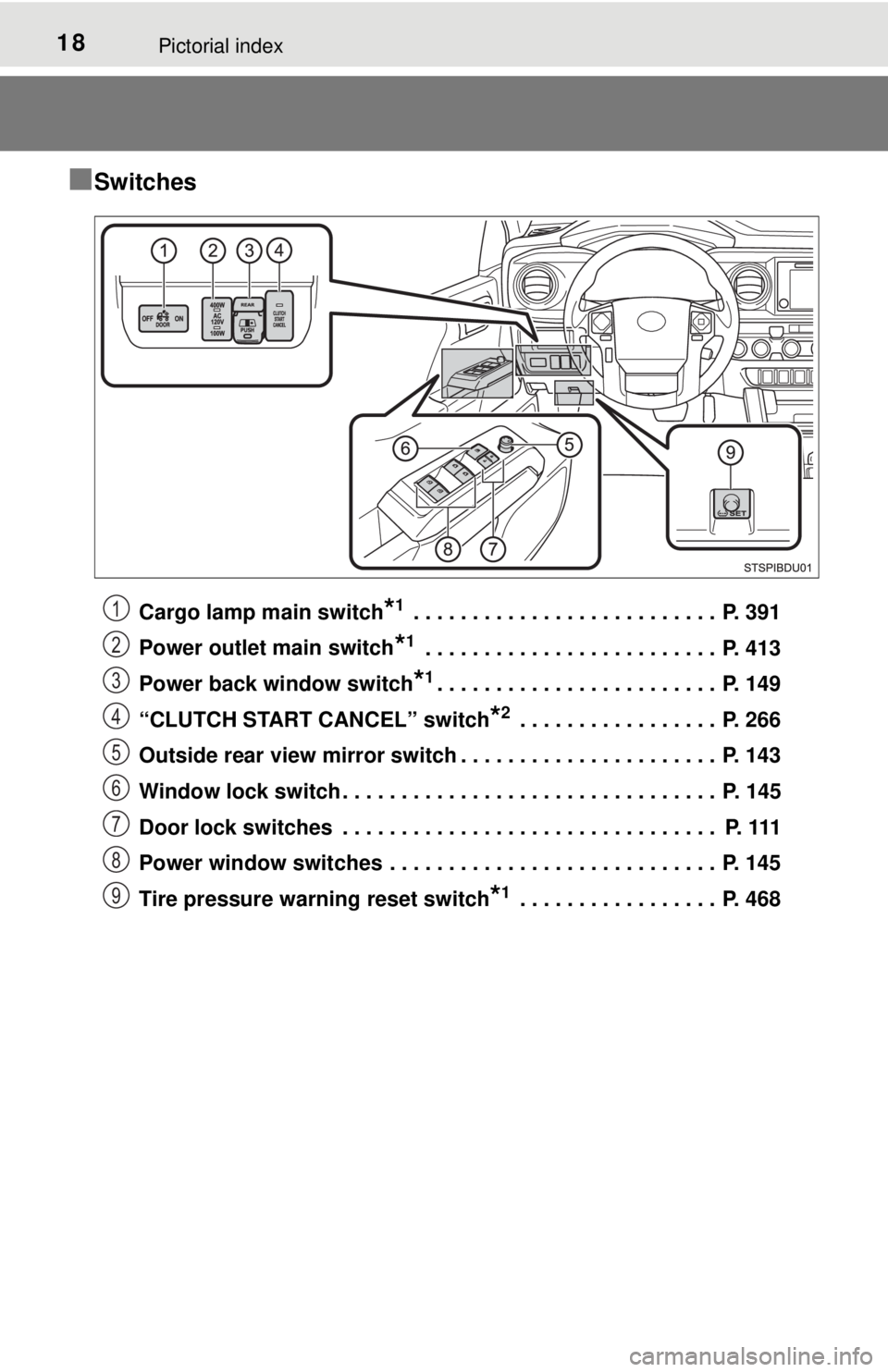
18Pictorial index
■Switches
Cargo lamp main switch*1 . . . . . . . . . . . . . . . . . . . . . . . . . . P. 391
Power outlet main switch
*1 . . . . . . . . . . . . . . . . . . . . . . . . . P. 413
Power back window switch
*1. . . . . . . . . . . . . . . . . . . . . . . . P. 149
“CLUTCH START CANCEL” switch
*2 . . . . . . . . . . . . . . . . . P. 266
Outside rear view mirror switch . . . . . . . . . . . . . . . . . . . . . . P. 143
Window lock switch . . . . . . . . . . . . . . . . . . . . . . . . . . . . . . . . P. 145
Door lock switches . . . . . . . . . . . . . . . . . . . . . . . . . . . . . . . . P. 111
Power window switches . . . . . . . . . . . . . . . . . . . . . . . . . . . . P. 145
Tire pressure warning reset switch
*1 . . . . . . . . . . . . . . . . . P. 468
1
2
3
4
5
6
7
8
9
Page 155 of 640

155
4Driving
4-1. Before drivingDriving the vehicle ............. 156
Cargo and luggage ........... 165
Vehicle load limits ............. 169
Trailer towing..................... 170
Dinghy towing ................... 188
4-2. Driving procedures Engine (ignition) switch (vehicles without
a smart key system) ........ 189
Engine (ignition) switch (vehicles with a smart
key system) ..................... 192
Automatic transmission ..... 197
Manual transmission ......... 202
Turn signal lever................ 204
Parking brake .................... 205
4-3. Operating the lights and wipers
Headlight switch ................ 206
Fog light switch ................. 210
Windshield wipers and washer ............................ 211
4-4. Refueling Opening the fuel tank cap .................................. 214 4-5. Using the driving support
systems
Cruise control .................... 218
Intuitive parking assist....... 223
Rear view monitor system ............................ 229
BSM (Blind Spot Monitor) ........ 239
• The Blind Spot Monitor function ......................... 241
• The Rear Cross Traffic Alert function ................. 244
Four-wheel drive system ... 247
AUTO LSD system............ 251
Rear differential lock system ............................ 253
Active traction control system ............................ 256
Multi-terrain Select ............ 258
Crawl Control .................... 262
Clutch start cancel switch .............................. 266
Driving assist systems ...... 267
4-6. Driving tips Winter driving tips ............. 273
Off-road precautions ......... 277
Page 156 of 640
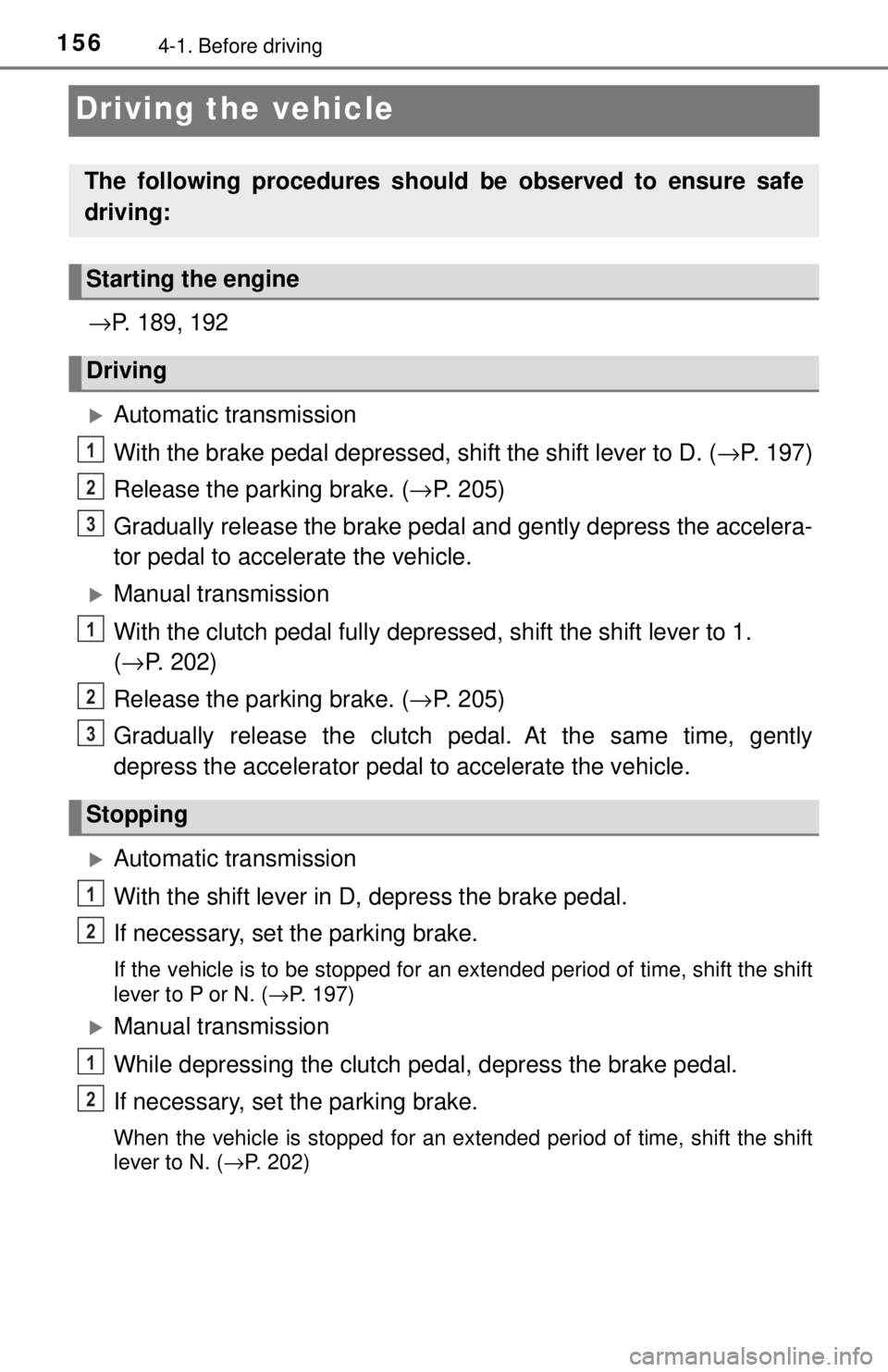
1564-1. Before driving
Driving the vehicle
→P. 189, 192
Automatic transmission
With the brake pedal depressed, shift the shift lever to D. ( →P. 197)
Release the parking brake. ( →P. 205)
Gradually release the brake pedal and gently depress the accelera-
tor pedal to accelerate the vehicle.
Manual transmission
With the clutch pedal fully depressed, shift the shift lever to 1.
( → P. 202)
Release the parking brake. ( →P. 205)
Gradually release the clutch pedal. At the same time, gently
depress the accelerator pedal to accelerate the vehicle.
Automatic transmission
With the shift lever in D, depress the brake pedal.
If necessary, set the parking brake.
If the vehicle is to be stopped for an extended period of time, shift the shift
lever to P or N. ( →P. 197)
Manual transmission
While depressing the clutch pedal, depress the brake pedal.
If necessary, set the parking brake.
When the vehicle is stopped for an extended period of time, shift the shift
lever to N. (→P. 202)
The following procedures should be observed to ensure safe
driving:
Starting the engine
Driving
Stopping
1
2
3
1
2
3
1
2
1
2
Page 157 of 640
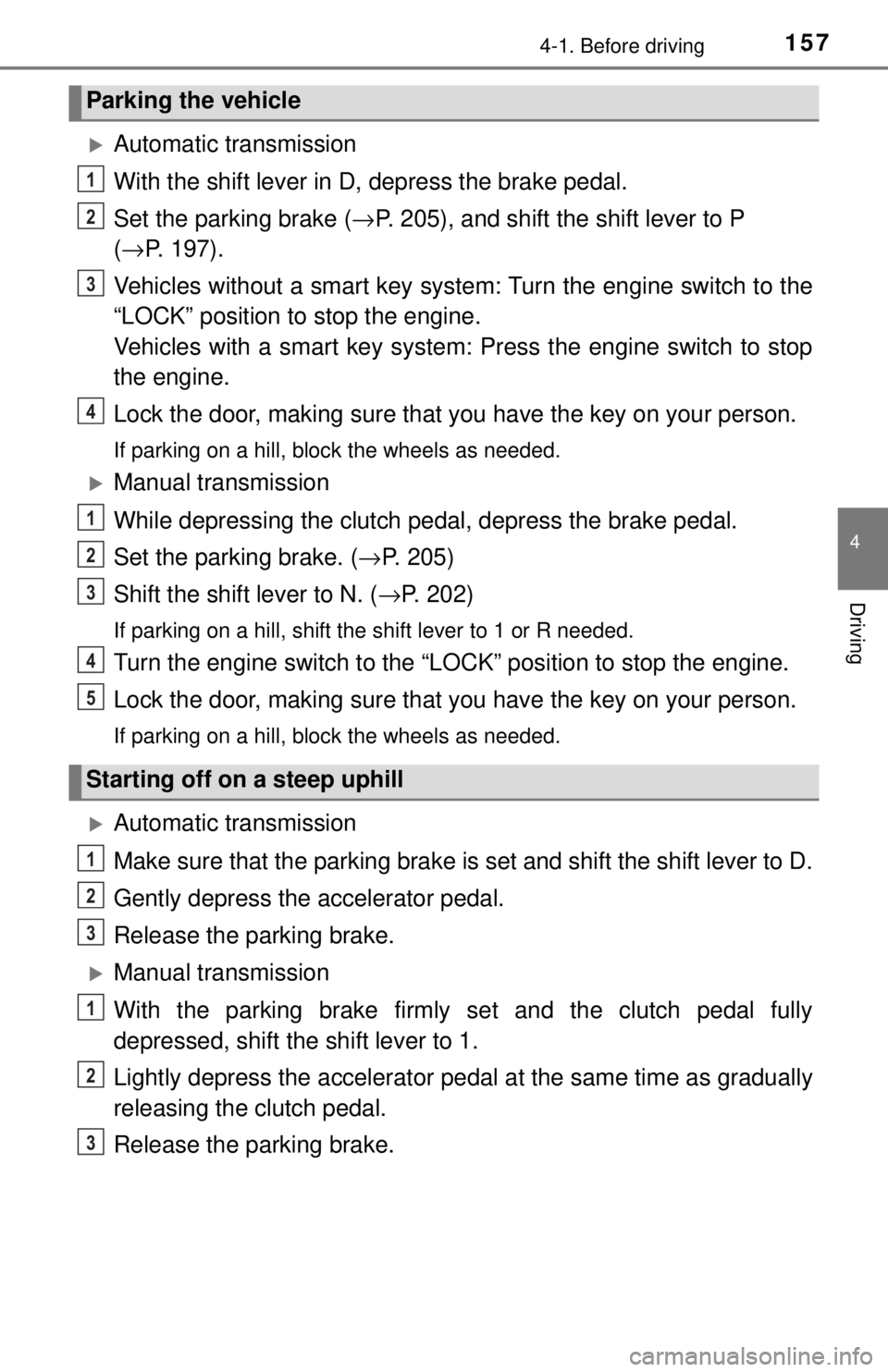
1574-1. Before driving
4
Driving
Automatic transmission
With the shift lever in D, depress the brake pedal.
Set the parking brake (→P. 205), and shift the shift lever to P
( → P. 197).
Vehicles without a smart key system: Turn the engine switch to the
“LOCK” position to stop the engine.
Vehicles with a smart key system : Press the engine switch to stop
the engine.
Lock the door, making sure that you have the key on your person.
If parking on a hill, block the wheels as needed.
Manual transmission
While depressing the clutch pedal, depress the brake pedal.
Set the parking brake. ( →P. 205)
Shift the shift lever to N. (→ P. 202)
If parking on a hill, shift the shift lever to 1 or R needed.
Turn the engine switch to the “LOC K” position to stop the engine.
Lock the door, making sure that you have the key on your person.
If parking on a hill, block the wheels as needed.
Automatic transmission
Make sure that the parking brake is set and shift the shift lever to D.
Gently depress the accelerator pedal.
Release the parking brake.
Manual transmission
With the parking brake firmly set and the clutch pedal fully
depressed, shift the shift lever to 1.
Lightly depress the accelerator pedal at the same time as gradually
releasing the clutch pedal.
Release the parking brake.
Parking the vehicle
Starting off on a steep uphill
1
2
3
4
1
2
3
4
5
1
2
3
1
2
3
Page 163 of 640
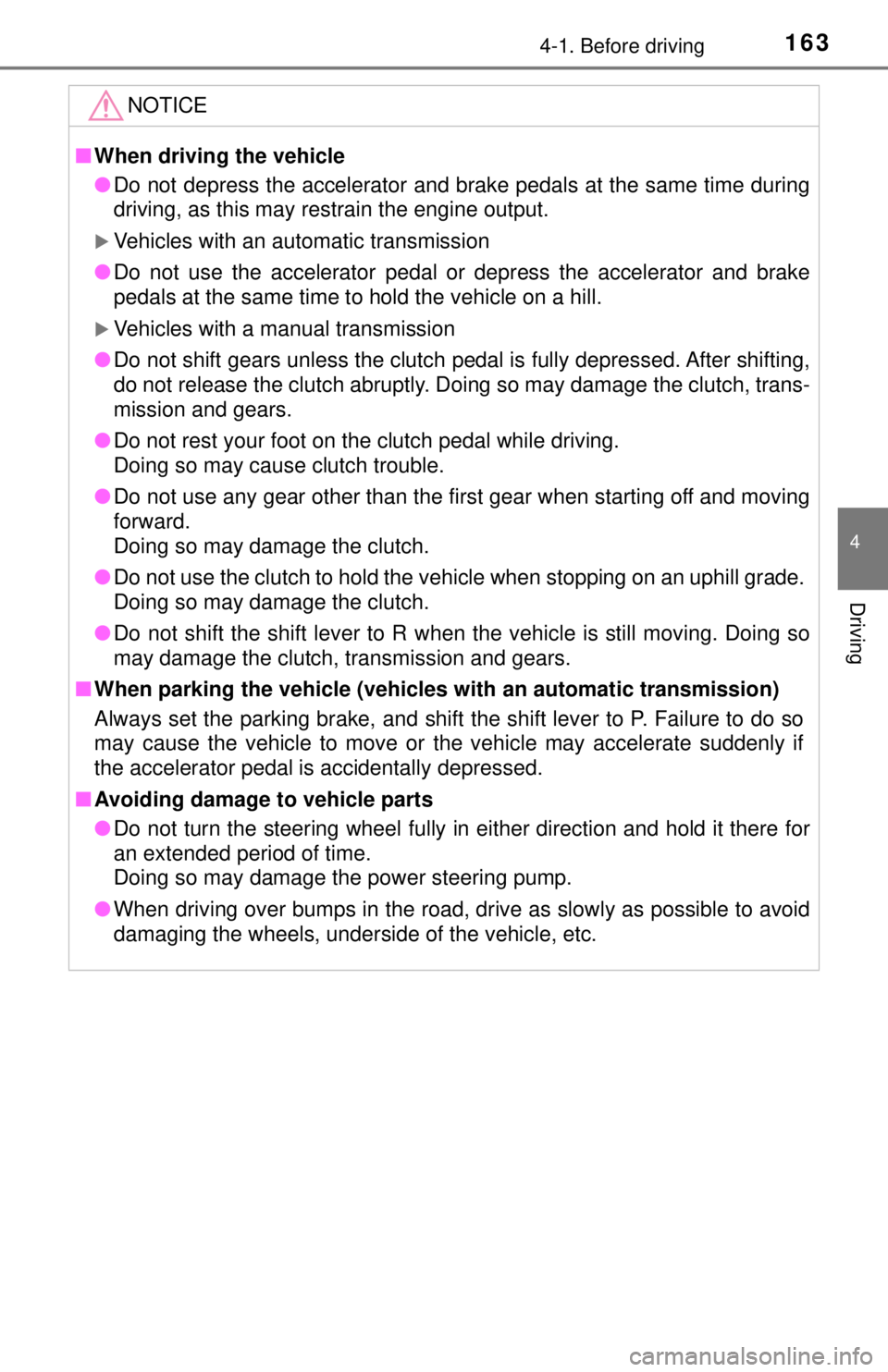
1634-1. Before driving
4
Driving
NOTICE
■When driving the vehicle
● Do not depress the accelerator and brake pedals at the same time during
driving, as this may restrain the engine output.
Vehicles with an automatic transmission
● Do not use the accelerator pedal or depress the accelerator and brake
pedals at the same time to hold the vehicle on a hill.
Vehicles with a manual transmission
● Do not shift gears unless the clutch pedal is fully depressed. After shifting,
do not release the clutch abruptly. Doing so may damage the clutch, trans-
mission and gears.
● Do not rest your foot on the clutch pedal while driving.
Doing so may cause clutch trouble.
● Do not use any gear other than the first gear when starting off and moving
forward.
Doing so may damage the clutch.
● Do not use the clutch to hold the vehicle when stopping on an uphill grade.
Doing so may damage the clutch.
● Do not shift the shift lever to R when the vehicle is still moving. Doing so
may damage the clutch, transmission and gears.
■ When parking the vehicle (vehicl es with an automatic transmission)
Always set the parking brake, and shift the shift lever to P. Failure to do so
may cause the vehicle to move or the vehicle may accelerate suddenly if
the accelerator pedal is accidentally depressed.
■ Avoiding damage to vehicle parts
● Do not turn the steering wheel fully in either direction and hold it there for
an extended period of time.
Doing so may damage the power steering pump.
● When driving over bumps in the road, drive as slowly as possible to avoid
damaging the wheels, underside of the vehicle, etc.
Page 183 of 640

1834-1. Before driving
4
Driving
●Always place wheel blocks under both the vehicle’s and the trailer’s
wheels when parking. Apply the parking brake firmly, and put the
transmission in P (automatic transmission) or in 1 or R (manual
transmission). Avoid parking on a slope, but if unavoidable, do so
only after performing the following:
Apply the brakes and keep them applied.
Have someone place wheel blocks under both the vehicle’s and
trailer’s wheels.
When the wheel blocks are in pl ace, release the brakes slowly
until the blocks absorb the load.
Apply the parking brake firmly.
Shift into P (automatic transmission) or 1 or R (manual transmis-
sion) and turn off the engine.
● When restarting after parking on a slope:
With the transmission in P (autom atic transmission) or the clutch
pedal (manual transmission) depr essed, start the engine. On
vehicles with an automatic transmission, be sure to keep the
brake pedal pressed.
Shift into a forward gear. If reversing, shift into R.
Release the parking brake (and also the brake pedal on vehicles
with an automatic transmission), and slowly pull or back away
from the wheel blocks. Stop and apply the brakes.
Have someone retrieve the blocks.
1
2
3
4
5
1
2
3
4
Page 189 of 640
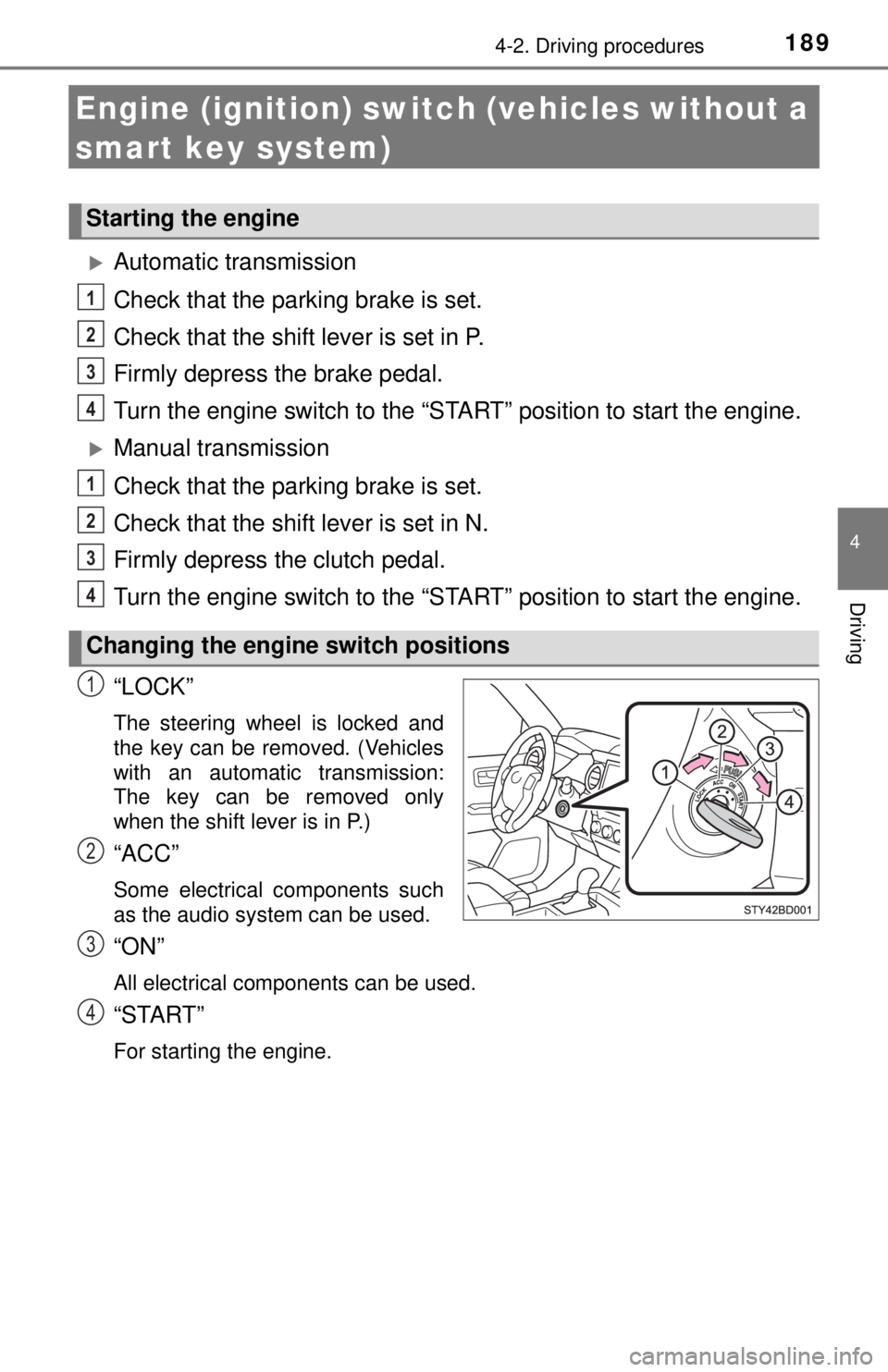
1894-2. Driving procedures
4
Driving
Engine (ignition) switch (vehicles without a
smart key system)
Automatic transmission
Check that the parking brake is set.
Check that the shift lever is set in P.
Firmly depress the brake pedal.
Turn the engine switch to the “S TART” position to start the engine.
Manual transmission
Check that the parking brake is set.
Check that the shift lever is set in N.
Firmly depress the clutch pedal.
Turn the engine switch to the “START” position to start the engine.
“LOCK”
The steering wheel is locked and
the key can be removed. (Vehicles
with an automatic transmission:
The key can be removed only
when the shift lever is in P.)
“ACC”
Some electrical components such
as the audio system can be used.
“ON”
All electrical components can be used.
“START”
For starting the engine.
Starting the engine
Changing the engine switch positions
1
2
3
4
1
2
3
4
1
2
3
4